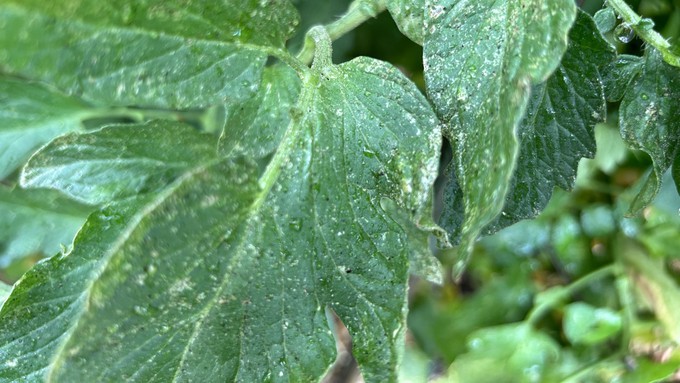
Stay hydrated and give your plants a morning shower

Spider mites cause damage by sucking cell contents from leaves, leaving stippling like this. As infestations increase, thin webbing will be visible on leaves and stalks. Kathy Morrison
How is heat affecting your garden? After a record-high 109 in Sacramento on Sunday, some plants may seem kind of crispy. (Or covered in spider mites.)
Sacramento may see a little Delta breeze relief on Tuesday and Wednesday. According to the National Weather Service, temperatures will top out in the low 90s midweek. That cool-off will come in part because overnight lows will return to normal; instead of sticking in the 70s, night-time temperatures will dip back down into the refreshing 50s. That will get mornings off to a cooler start, too.
But more triple-digit days are coming soon. The weather service predicts Sacramento will see 106 on Friday and 102 on Saturday.
“Keep your water bottle close by,” tweeted the NWS Sacramento office Monday morning.
Staying hydrated is important for people, pets and plants. Wildlife could use some water, too; a shallow saucer of water can become a bee oasis. Refill the bird bath.
Limit outdoor activity to before 10 a.m., if possible. Remember: Drink before you’re thirsty.
As for your garden, irrigate in the early morning (preferably) or late evening to cut down on evaporation.
Large-leaf plants such as hydrangeas or squash tend to wilt in the afternoon; that’s normal. If they’re still droopy in the morning, they likely need water.
Check soil moisture before irrigating; plant stress signs indicating too much water (yellow leaves, droopiness, dropped foliage, etc.) look similar to not enough. Container plants, which may need daily watering in this heat, can become over-watered if drainage holes are blocked; their roots drown in all the extra water.
This heat wave has brought dry, dusty conditions – perfect for an explosion of spider mites. And that’s just what we’ve seen, particularly on tomatoes and roses.
The best and fastest remedy for spider mites: Water. Give your plants a shower. With the hose, spray plants, washing off the mites’ webs. Try to wet the bottom side of foliage, too. No miticide is necessary, and the plant will appreciate the extra irrigation.
Spraying dust off leaves can help prevent a mite attack before you see those telltale webs. It also helps the leaves “breathe” and cope with hot weather. It’s better to shower plants in the morning so foliage has a chance to dry completely (and avoid fungal outbreaks), but that’s not a problem this week; common fungal diseases (such as powdery mildew) are inactive in this heat.
For more advice on spider mites: https://ipm.ucanr.edu/PMG/PESTNOTES/pn7405.html.
Comments
0 comments have been posted.Sacramento Digs Gardening to your inbox.
Food in My Back Yard Series
May 6: Maintain soil moisture with mulch for garden success
April 29: What's (already) wrong with my tomato plants?
April 22: Should you stock up on fertilizer? (Yes!)
April 15: Grow culinary herbs in containers
April 8: When to plant summer vegetables
April 1: Don't be fooled by these garden myths
March 25: Fertilizer tips: How to 'feed' your vegetables for healthy growth
March 18: Time to give vegetable seedlings some more space
March 11: Ways to win the fight against weeds
March 4: Potatoes from the garden
Feb. 25: Plant a fruit tree now -- for later
Feb. 18: How to squeeze more food into less space
Feb. 11: When to plant? Consider staggering your transplants
Feb. 4: Starting in seed starting
Sites We Like
Garden Checklist for week of May 11
Make the most of the lower temperatures early in the week. We’ll be back in the 80s by Thursday.
* Plant, plant, plant! It’s prime planting season in the Sacramento area. Time to set out those tomato transplants along with peppers and eggplants. Pinch off any flowers on new transplants to make them concentrate on establishing roots instead of setting premature fruit.
* Direct-seed melons, cucumbers, summer squash, corn, radishes, pumpkins and annual herbs such as basil.
* Harvest cabbage, lettuce, peas and green onions.
* In the flower garden, direct-seed sunflowers, cosmos, salvia, zinnias, marigolds, celosia and asters. (You also can transplant seedlings for many of the same flowers.)
* Plant dahlia tubers.
* Transplant petunias, marigolds and perennial flowers such as astilbe, columbine, coneflowers, coreopsis, dahlias, rudbeckia and verbena.
* Keep an eye out for slugs, snails, earwigs and aphids that want to dine on tender new growth.
* Feed summer bloomers with a balanced fertilizer.
* For continued bloom, cut off spent flowers on roses as well as other flowering plants.
* Add mulch to the garden to maintain moisture. Mulch also cuts down on weeds. But don’t let it mound around the stems or trunks of trees or shrubs. Leave about a 6-inch-to-1-foot circle to avoid crown rot or other problems.
* Remember to weed! Pull those nasties before they set seed.
* Water early in the day and keep seedlings evenly moist.